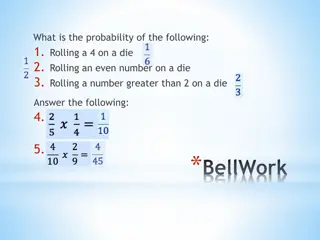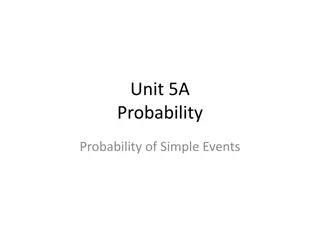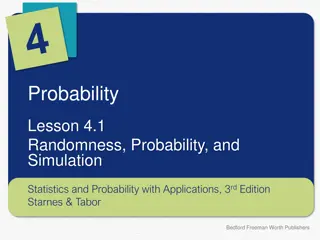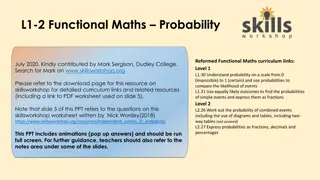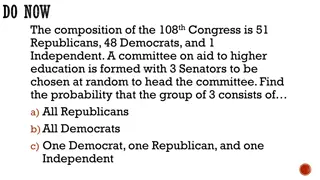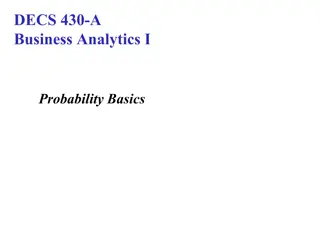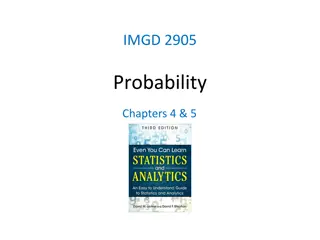Understanding Probability Rules and Applications
Explore the concepts of independent and dependent events, multiplication rules, conditional probability, and their applications in various scenarios such as coin tossing, survey analysis, and crime investigations. Gain insights into calculating probabilities for different events and understanding their relationships in statistical contexts.
Download Presentation

Please find below an Image/Link to download the presentation.
The content on the website is provided AS IS for your information and personal use only. It may not be sold, licensed, or shared on other websites without obtaining consent from the author. Download presentation by click this link. If you encounter any issues during the download, it is possible that the publisher has removed the file from their server.
E N D
Presentation Transcript
4-4 Multiplication Rules
4.4 Multiplication Rules Two events A and B are independent events if the fact that A occurs does not affect the probability of B occurring. Multiplication Rules B P A P B = ( ) ( ) ( ) P A P B A ( ) ( and Independent P A ) ( ) = and Dependent P A B Bluman, Chapter 4
Example 4-23: Tossing a Coin A coin is flipped and a die is rolled. Find the probability of getting a head on the coin and a 4 on the die. Independent Events ( ) ( ) 1 ( ) 4 = Head and 4 Head P P 1 1 2 6 P = = 12 This problem could be solved using sample space. H1, H2, H3, H4, H5, H6, T1, T2, T3, T4, T5, T6 3 Bluman, Chapter 4
Example 4-26: Survey on Stress A Harris poll found that 46% of Americans say they suffer great stress at least once a week. If three people are selected at random, find the probability that all three will say that they suffer great stress at least once a week. Independent Events S and S and S ( ) ( ) S 0.46 0.46 0.46 ( ) S ( ) S = = )( P P ( P P )( ) = 0.097 4 Bluman, Chapter 4
Example 4-28: University Crime At a university in western Pennsylvania, there were 5 burglaries reported in 2003, 16 in 2004, and 32 in 2005. If a researcher wishes to select at random two burglaries to further investigate, find the probability that both will have occurred in 2004. Dependent Events ( ) ( ) ( ) = C and C C C C P P P 1 2 1 2 1 15 52 16 53 60 689 = = 5 Bluman, Chapter 4
4.4 Conditional Probability Conditional probability is the probability that the second event B occurs given that the first event A has occurred. Conditional Probability P A P B A = ( ) and B ( ) ( ) P A Bluman, Chapter 4
Example 4-33: Parking Tickets The probability that Sam parks in a no-parking zone and gets a parking ticket is 0.06, and the probability that Sam cannot find a legal parking space and has to park in the no-parking zone is 0.20. On Tuesday, Sam arrives at school and has to park in a no- parking zone. Find the probability that he will get a parking ticket. N= parking in a no-parking zone, T= getting a ticket ( ) ( ) N P ( ) N and T P 0.06 0.20 = = = T N P 0.30 7 Bluman, Chapter 4
Example 4-34: Women in the Military A recent survey asked 100 people if they thought women in the armed forces should be permitted to participate in combat. The results of the survey are shown. 8 Bluman, Chapter 4
Example 4-34: Women in the Military a. Find the probability that the respondent answered yes (Y), given that the respondent was a female (F). 8 ( ) F and Y P P 8 4 25 ( ) 100 50 100 = = = = Y F P ( ) F 50 9 Bluman, Chapter 4
Example 4-34: Women in the Military b. Find the probability that the respondent was a male (M), given that the respondent answered no (N). 18 100 60 100 ( ) N and M P P 18 60 3 ( ) = = = = M N P ( ) N 10 10 Bluman, Chapter 4
Probabilities for At Least and At Most At Least All probabilities larger than the given probability EX: You must be at least 5 feet to ride the roller coaster means everyone 5 feet or taller At Most All probabilities smaller than the given probability EX: I have at most $20 in my purse means I have $20 or less Bluman, Chapter 4
Example 1: Bow Ties The Neckware Association of America reported that 3% of ties sold in the United States are bow ties (B). If 4 customers who purchased a tie are randomly selected, find the probability that at least 1 purchased a bow tie. ( ) B 0.03, B 1 0.03 P P = = ( ) ( ) ( )( 0.97 0.97 0.97 0.97 = ( ) at least 1 bow tie 1 P = = ( ) no bow ties = 0.97 ( ) )( ( ) B ( ) B = B B P P P P P )( ) = 0.885 ( ) no bow ties P = 1 0.885 0.115 12 Bluman, Chapter 4
Homework Pg. 209 #1, 7, 8, 32, 34




